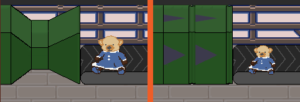In my last sprint report, I finished up my work of updating my build scripts to create an iOS project successfully to deal with Apple’s latest requirements, and then I turned my attention back on addressing Google’s new requirements.
Sprint 27: Make publishable
Planned and Completed:
- Defect: game plays in portrait mode instead of landscape (Android)
Not completed:
- Add juiciness to dispenser
- Defect: game seems unresponsive on main menu screen (Android)
The good news was that I didn’t need to change too much of my existing Android build process. I basically needed to replace the older SDL2’s android-project directory with the new one, change a few files so that it did what I expected, and then change my CMake files so that it used the new gradle-based build rather than the old ant-based build. I was pleased that aside from a few things, much of the work was changing the directory names to match what was expected.
While the SDL2 docs mention using the command ./gradlew debugInstall, I wanted to have more fine-grained control. I wanted to be able to run three separate steps: build either a debug or release build, sign a release binary, and install the APK.
When I checked the Android docs, they mentioned the arguments assembleDebug and assembleRelease, so building is as easy as changing the argument to gradlew.
While I haven’t uploaded to the Google Play store yet, signing looks like it is the same as before, which I do with jarsigner and zipalign. I assume that since I can run a signed release build on my own hardware that it is not going to require any changes when I do upload it, but I’m prepared to learn otherwise.
And installing, either in the Android emulator or on my device, uses adb as before.
One thing I ran into was that the build would look like it was fine, but then suddenly I’d get a bunch of linker errors along the lines of:
undefined reference to 'std::logic_error::logic_error(char const*)
It turned out that in android-project/app/jni/Android.mk, I needed to uncomment the APP_STL line to make sure it uses the C++ STL that my project requires. Then it built correctly.
I sent the latest builds off to my testers. Based on my own testing in the emulator and using adb shell to play with input tap, I’m worried that the touchpress detection is still not working in Android 11. I was using SDL2 2.0.14, and I even tried by downloading the latest in-development branch from GitHub, and it still didn’t respond correctly. But maybe my tester who was having issues on his device will see something different.
In the meantime, my other tester who reported that the game runs in portrait mode instead of landscape mode on his phone informed me that the new build does in fact run in landscape mode correctly now. So that’s one defect fixed!
While I wait to hear back from my other tester, I got back to actual game design work. I started experimenting with some graphical enhancements that didn’t pan out, then I started working on updating the dispenser’s look.
This new dispenser is a bit bulkier to hide the fact that it basically draws over the toys. The old dispenser had a skinny part, and toys would show in the background, which broke the illusion that they were coming out of the dispenser.
But this new dispenser also allows me to make it clear if turns were advancing or not. One thing I was told by one tester was that it wasn’t very obvious at times that you needed to hit the Go button to make things move forward, especially when you were hiring or telling a worker to do something. The game is kinda continuous-turn-based, and so it continues until you perform such an activity, and then it stops everything, and you have to hit Go to again.
Right now, the only indication you have is that the button says Go instead of Stop, and the fact that nothing is moving.
So I wanted to make the dispenser light up when the machines were active, and perhaps have a different animated light to indicate that it was stopped.
I might change it so that one of the arrows is a lever, which is up when it is running or down when it isn’t, with a blinking light to make it clear which setting it is.
Anyway, I’m easing back into it, but I’m happy to get back to actual game development rather than fighting with platform-specific changes brought about by other companies changing requirements.
Thanks for reading!
—
Want to learn when I release updates to Toytles: Leaf Raking or about future Freshly Squeezed games I am creating? Sign up for the GBGames Curiosities newsletter, and get the 24-page, full color PDF of the Toytles: Leaf Raking Player’s Guide for free!


One reply on “Freshly Squeezed Progress Report – Android Defect Fix and New Dispenser Art”
[…] my previous sprint report, I talked about updating my project to use SDL2’s new android-project directory and […]